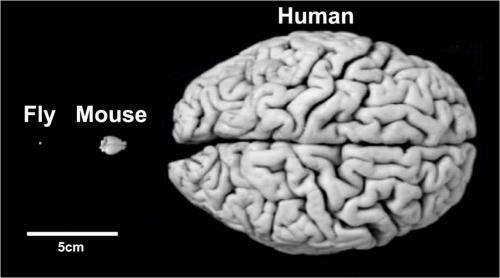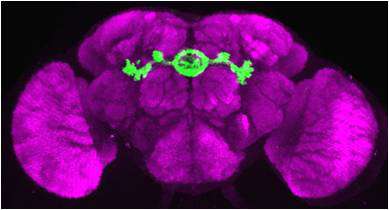'Strikingly similar' brains of man and fly may aid mental health research

A new study by scientists at King's College London and the University of Arizona (UA) published in Science reveals the deep similarities in how the brain regulates behaviour in arthropods (such as flies and crabs) and vertebrates (such as fish, mice and humans). The findings shed new light on the evolution of the brain and behaviour and may aid understanding of disease mechanisms underlying mental health problems.
Based on their own findings and available literature, Dr Frank Hirth (King's) and Dr Nicholas Strausfeld (UA) compared the development and function of the central brain regions in arthropods (the 'central complex') and vertebrates (the 'basal ganglia').
Research suggests that both brain structures derive from embryonic stem cells at the base of the developing forebrain and that, despite the major differences between species, their respective constitutions and specifications derive from similar genetic programmes.
The authors describe that nerve cells in the central complex and the basal ganglia become inter-connected and communicate with each other in similar ways, facilitating the regulation of adaptive behaviours. In other words, the response of a fly or a mouse to internal stimuli such as hunger or sleep, and external stimuli such as light/dark or temperature, are regulated by similar neural mechanisms.

Dr Hirth from King's College London Institute of Psychiatry says: "Flies, crabs, mice, humans: all experience hunger, need sleep and have a preference for a comfortable temperature so we speculated there must be a similar mechanism regulating these behaviours. We were amazed to find just how deep the similarities go, despite the differences in size and appearance of these species and their brains."
Dr Strausfeld, a Regents Professor in the UA's Department of Neuroscience and the Director of the UA's Center for Insect Science, says: "When you compare the two structures, you find that they are very similar in terms of how they're organized. Their development is orchestrated by a whole suite of genes that are homologous between flies and mice, and the behavioral deficits resulting from disturbances in the two systems are remarkably similar as well."
In humans, dysfunction of the basal ganglia can cause severe mental health problems ranging from autism, schizophrenia and psychosis, to neurodegeneration - as seen in Parkinson's disease, motor neurone disease and dementia - as well as sleep disturbances, attention deficits and memory impairment. Similarly, when parts of the central complex are affected in fruit flies, they display similar impairments.
Dr Hirth (King's) adds: "The deep similarities we see between how our brains and those of insects regulate behaviour suggest a common evolutionary origin. It means that prototype brain circuits, essential for behavioural choice, originated very early and have been maintained across animal species throughout evolutionary time. As surprising as it may seem, from insects' dysfunctional brains, we can learn a great deal about how human brain disorders come about."
The findings suggest that arthropod and vertebrate brain circuitries derive from a common ancestor already possessing a complex neural structure mediating the selection and maintenance of behavioural actions.
Although no fossil remains of the common ancestor exist, trace fossils, in the form of tracks criss-crossing the seafloor hundreds of millions of years ago, reveal purposeful changes in direction.
Dr Strausfeld (UA) says: "If you compare these tracks to the tracks left behind by a foraging fly larva on an agar plate or the tunnels made by a leaf-mining insect, they're very similar. They all suggest that the animal chose to perform various different actions, and action selection is precisely what the central complex and the basal ganglia do."
The trace fossils may thus support the early existence of brains complex enough to allow for action selection and a shared ancestry of neural structures between invertebrates and vertebrates.
More information: "Deep Homology of Arthropod Central Complex and Vertebrate Basal Ganglia," by N.J. Strausfeld, Science, 2013.















